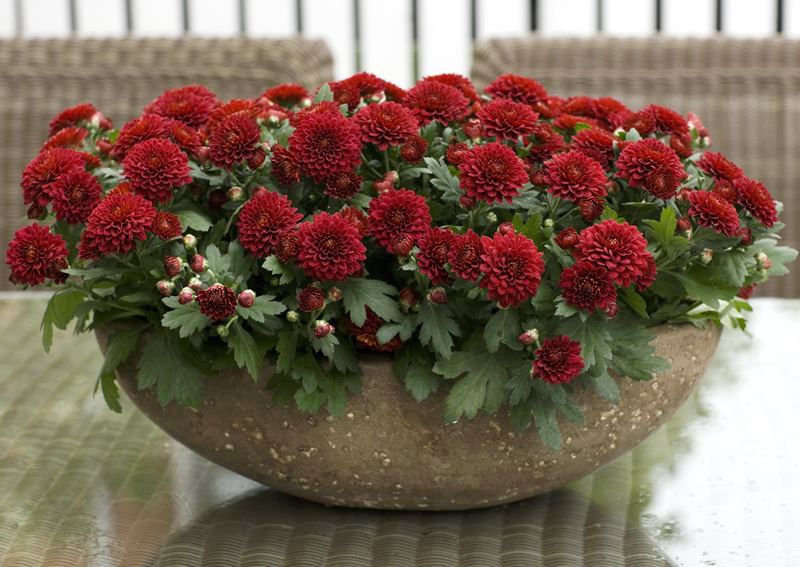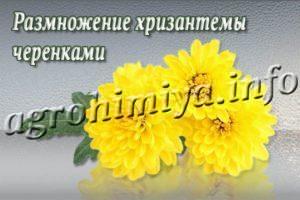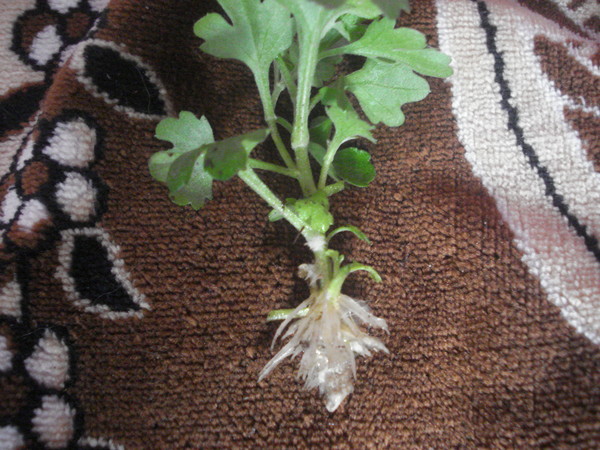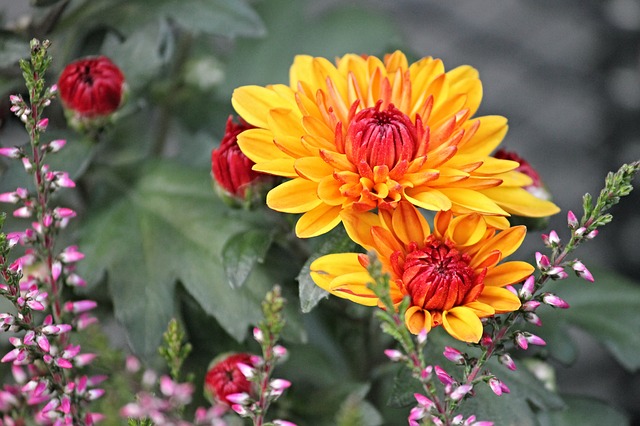Reproduction from bouquets
It is very easy to propagate chrysanthemums from bouquets. For this, the flowers in the vase must fade. Further, they remove all the leaves and pinch the top. They change the water in the vase and wait for the roots to appear for transplanting into a pot or flower bed.
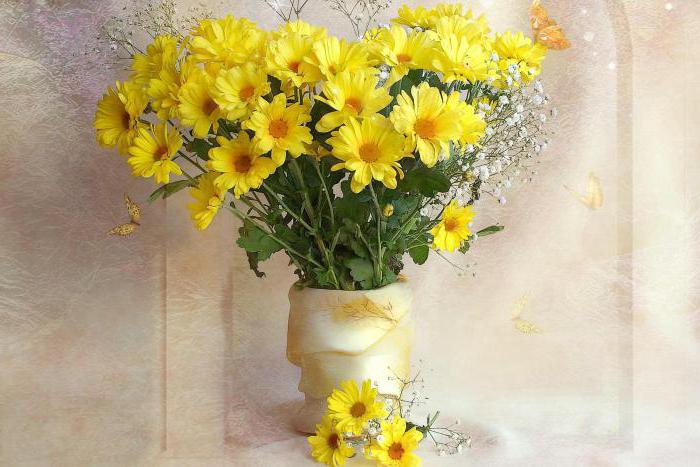
Seeds can also be harvested from dry chrysanthemums with small flowers. They will make good seedlings in the spring.
Reproduction of chrysanthemums, the methods and features of which are described above, are easy to perform, and in the future it is necessary to focus on the following points:
- for the formation of buds, bushes need a short day and a long night;
- long daylight hours are needed for plant growth and leaf formation;
- highly moistened soil is needed by plants with thin and large leaves;
- the bushes must be weeded and the soil under them loosened once every ten to twelve days;
- apply mineral fertilizers several times per season.
After familiarizing yourself with the features of each plant propagation method and applying them in practice, you can decorate your gardens with lush and bright chrysanthemum bushes, which will delight the eye until late autumn.
Reproduction of chrysanthemums by cuttings from a bouquet
Usually, chrysanthemums propagate by cuttings in the fall. At this time, the plants are in bloom. Breeding chrysanthemums with cuttings has several advantages. First, it allows you to quickly plant exactly the flowers you like. You will immediately see what size, shape and color the buds of the future chrysanthemum will be. When buying a flower bush in the spring, you won't know all this. You just have to trust the seller's assurances.
Another advantage is the low cost of the planting method. You will not pay for the flower as planting material. You will take it from an already purchased bouquet. Agree that this is a nice bonus.
Choosing a flower
Start breeding chrysanthemums by cuttings by choosing a suitable flower. It is good if it is a stem with shoots. Such planting material takes root and grows faster. But if there are no such branches, an ordinary flower will do. Choose several cuttings at once, this will increase the likelihood of flowers rooting.
You should not choose flowers with bright signs of the disease. Most likely they won't. In addition, the infection can spread to other indoor flowers if they are nearby.
What to do with a flower?
The chrysanthemum flower must be trimmed. Cut off the bottom of the cutting, as well as the top, that is, the bud itself. Remove all leaves and side shoots from the remaining branch, as they draw forces from the stem that must go for rooting.
After that, the cutting is placed in water. You can add Kornevin or another drug to it that activates the appearance of roots. You can also add activated carbon to the water. It neutralizes microorganisms that usually cause putrefactive processes. This will reduce the likelihood of cuttings rotting.
In the water, the stalk of the chrysanthemum should stand until it takes root. This can take a month. If suddenly the twig starts to rot, then do the following:
- Cut the bottom off to a healthy spot.
- Change the water in the glass.
- Add activated charcoal to it.
This way, you will save the cutting and give it a second chance at rooting. As soon as the roots appear, plant the flower in a pot.
Do not be afraid if the flower in the glass begins to dry out. Outwardly, it seems spoiled, but in fact, it may soon take root.
Which pot is better to take?
Breeding chrysanthemums with cuttings is not very fast. Therefore, you do not need to immediately buy a huge flowerpot. For the first time, a small, not deep one is enough. The main thing is that it is wide.In such a container, the chrysanthemum will gradually develop the soil. When the flower grows up, you can transplant it into a large pot.
Why can't you use a large flowerpot right away? The fact is that the plant cannot immediately master the entire soil. As a result, unused moisture may stagnate in places. This leads to the appearance of putrefactive processes and pests. In addition, the soil can acidify, which will also negatively affect the condition of the chrysanthemum. Therefore, it is better to use a pot of the optimal size. In it, the roots will occupy almost the entire area.
Chrysanthemum soil
How to breed chrysanthemums at home and what kind of soil should be selected for them? These flowers grow well in loose, nutritious soil. The earth, poorly saturated with minerals, is not suitable for them. Also, chrysanthemums do not feel comfortable in dense heavy soil. For the soil to be optimal in its structure, prepare it yourself. To do this, buy:
- universal substrate;
- perlite;
- sand;
- coconut fiber.
All this must be mixed in such a way that a loose, breathable soil is obtained. You can add a little dry fertilizer to it. But you should not be zealous with mineral supplements. You will still have time to fertilize the soil when the chrysanthemum is well rooted.
How to breed chrysanthemums at home: planting process
When the flowerpot and soil are ready, you can start planting the cutting
This must be done carefully so as not to break off the tender, only emerging roots. You can pour a little water into the hole prepared for the cutting
You need to cover the flower with soft, loose earth. It is not necessary to trample it strongly, but you should also not plant the flower so that it dangles.
Appearance and useful properties

Large and medium-sized chrysanthemum flowers are terry in shape and in the form of daisies are painted in such bright, saturated tones of the most beautiful shades of white, pink, yellow, lilac and purple that you can endlessly look at them. There are two-tone specimens, which are also difficult to take your eyes off.
The flower tends to emit useful phytoncides that purify the surrounding air from gases and harmful impurities emitted by devices and finishing building materials working in the apartment. It is useful to inhale the scent of chrysanthemum - its scent heals the nerves and soothes a person.
Chrysanthemum cuttings in spring
The best time for grafting is spring. The period from March to April is for the early varieties of chrysanthemums, from April to May for the middle and late varieties. How to quickly grow chrysanthemums from cuttings for spring planting in the ground? This is not difficult.
When to cut a chrysanthemum

From the middle or the end of February, the bush is transferred to a warm room and watered abundantly. It is possible, but not necessary, to feed the plant with organic fertilizer. Ammonium nitrate gives good growth.
When young shoots appear - after about 8-12 days, they are allowed to grow up to 10-12 cm, and then they are cut to the full length.
Important! The cut branch should have at least four empty segments - the distances between the leaves, which are called internodes.
How to prepare cuttings
The tops are broken off or cut off completely, leaving 2-5 leaves on the uterine hemp - this is enough to resume growth. On the cuttings themselves, in order to avoid their decay, the lower leaves are removed and the upper ones are shortened by 1/3 - they pinch, if there are side small buds on the shoot, they are also cut off, and then planted.
Important! For rooting, the strongest and most resilient cuttings are left at the base. With a soft or hard base, the processes are discarded
Planting the cuttings in the substrate

The soil for planting must be well moistened. The depth of the hole is no more than 2 cm, the distance between the cuttings is 5-6 cm, if three or four cuttings are planted in a container. You can plant one cuttings at a time in a small pot or plastic cup.
How to care for a cutting
If these are medium and late varieties and the weather is warm enough, the containers are taken outside, into fresh air, but placed under a canopy to protect them from rain and gusts of wind.
Watered sparingly and carefully, avoiding either drying out of the soil or excess water. 14-16 days after rooting, the cuttings can be transplanted to a permanent place.
Early varieties, when it is still cold enough in the yard, are covered with foil so that the boxes with cuttings are under the dome. The free space between the tops of the cuttings and the film is left at least 35 cm.
Water enough, periodically removing the film. The main sign of rooting is the growth and appearance of new leaves. After the appearance of 5-7 new sheets, pinching is done. The second time, the upper leaves are shortened when the lateral shoots reach a length of 9-10 cm.
Did you know? Thanks to the regular pinching of the shoots as they grow back, a neat, beautiful bush with good weather resistance is formed.

For 7-10 days before planting, "film" cuttings must be hardened. To do this, they are opened and taken out onto the veranda or balcony, they can be placed near an open window without drafts, and it is better to cover them again at night. They are planted in the ground after the threat of frost has passed.
There is a way how to propagate chrysanthemum by cuttings without first germination and rooting in containers. This is another option for spring cuttings of chrysanthemums - directly into the ground.
It is made in late spring in mid - early May and June, that is, when the weather is warm. Cuttings are cut from overwintered bushes that have already given young shoots.
To do this, a new branch of chrysanthemum should grow by 14-15 cm. Cut it to half - about 7-8 cm. Plant immediately in a high bed, sprinkle with sand and water.
The top is covered with a film, the air gap between the top of the cutting and the film is at least 50 cm.If the weather is warm, then you do not need to cover it with polyethylene; if it is colder, then it is covered.
After 15-18 days after rooting, the seedlings can be transplanted to their permanent designated place.
Important! Chrysanthemums are light-requiring, and it is better to plant them in open, not shaded places. So they will develop and bloom better.
With proper placement on the site and care, chrysanthemums can bloom for more than a month.
Reproduction through seedlings
Reproduction of chrysanthemums is also possible through seedlings. For this, the seeds are sown in small boxes, at the bottom of which a drainage layer of sand is laid.
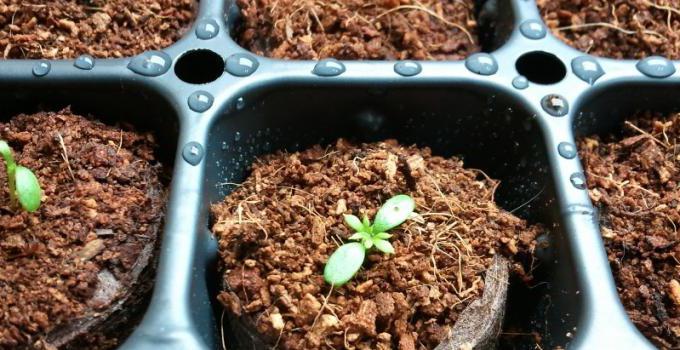
The covered containers are stored at an air temperature of 25 ° C. In two weeks, the first shoots will appear, which must be gradually hardened, removing the film, first for one, and then for two hours, and so on. The strongest seedlings dive after 3-4 leaves have formed on them. Young plants grow very slowly and reach 20 cm in height only after a month and a half at a temperature of 18 ° C.
Plants are planted in a permanent place at the end of May. The landing site must be protected from the wind and well lit. From fertilizers, it is best to apply humus. Clay or sandy soil should be improved with organic fertilizers.
How to propagate indoor chrysanthemum. How to propagate chrysanthemum?

It is difficult to find a summer cottage where chrysanthemums grow, decorating the landscape from July to late autumn. To grow this flower, while maintaining its varietal qualities, you need to know some of the rules for its propagation.

Timing
The timing is influenced, first of all, by the method chosen for the reproduction of the chrysanthemum. The timing of the planting of seeds determines the time of the beginning of its flowering. Early flowering varieties for seedlings are sown in late February or early March, and late flowering varieties are sown from 20 March to the first half of April. When planting seeds directly into the ground, sowing is carried out in May.
When grafting, the uterine bush is picked up in the fall, although the cuttings will be cut in the spring.The timing of spring cuttings also depends on the beginning of flowering: cuttings of early flowering chrysanthemums are carried out in February, middle cuttings in March, and late cuttings in early April.
However, chrysanthemum can also be propagated by cuttings in summer and autumn.

Reproduction of the plant by dividing the bush is most effective in early spring, when young shoots appear. If necessary, you can divide the bush in the summer, even during flowering. Summer division is best done in June under conditions of active plant growth or at the end of August.
Important! The timing of the reproduction of chrysanthemum is also influenced by its variety and type: it is customary to propagate single-stemmed in April, May and early June, and multi-stemmed, large and small-flowered - in March

The necessary conditions
Certain conditions are necessary for successful breeding. First of all, you need to choose the right shoots for the cuttings: it must have at least 4 leaves. It is not recommended to use either too underdeveloped or, conversely, fattening shoots. Woody shoots or if the internodes on them are too close are also not suitable. In autumn cuttings, a mother bush with pronounced varietal properties in the inflorescences should be selected. The plant should be vigorous with no signs of disease or pest infestation.

A bush dug in the fall and transplanted into a bowl should be kept in a cool room until spring. If the room has good humidity, then the mother bush does not need to be watered. Only when the soil dries up should it be slightly moistened. The best temperature regime in the room should be from +5 to +8 degrees. The effectiveness of cuttings depends on the number of young shoots. In order for them to be enough, in February the bush should be placed in a warm, well-lit place and in the future, regular watering should be carried out.
Only those new shoots that grow from the root system are chosen for cuttings. After planting the cuttings in a separate container, they create conditions such as:
- the temperature of the content should be from +15 to +20 degrees;
- the seedlings are covered with polyethylene for 2-3 weeks until they take root; the distance from the film to the top of the cutting should be within 30 cm;
- periodically carry out water spraying (in hot weather up to 2-3 times a day);
- Feed the cuttings 2-3 times a month;
- in strong sunlight, cuttings should be shaded, especially in the first 7-10 days after planting.
Bloom

Chrysanthemums bloom at home for a long time, more than a month. Flowering occurs in the autumn months. For more lush flowering, during the growing season, until mid-August, it is necessary to pinch the shoots two or three times. In order for the plant to develop more actively and form a larger number of buds, use biological products that stimulate its growth, such as Bud, Epin, Zircon. It is believed that the use of a light solution of potassium humate contributes to the rapid growth of the plant, the growth of its root system and an increase in the number and size of buds.
In the future, during flowering, regularly cut off dried stems and faded buds so as not to create conditions for pests and not to spoil the decorative appearance of the bush.
What to do if the chrysanthemum has faded?

In natural conditions, after the chrysanthemums have faded, winter sets in. Bushes go into hibernation. You need to create something similar at home.
After your chrysanthemum has faded, cut off all its shoots to a height of 10 - 15 cm, weak and diseased - cut at the root. Water and store in a cool, dark place until spring. The temperature of its content in winter should be in the region from zero to three degrees. Such temperatures are maintained in cellars and basements in winter. There you will keep the flower until spring. In early spring, when the growth of new shoots begins, the plant is brought into the room, transplanted into new soil and placed on a well-lit windowsill.
If you do not have a basement or a suitable cellar, the chrysanthemum will have to be kept in some other suitable place during the winter. An insulated balcony, a glazed veranda or a window sill in the entrance, where the temperature will not exceed 8 grams, will do. Watering is almost not required, once during the entire wintering period will be enough.
If there is no cool room in the house, your chrysanthemum will have to spend the winter on the windowsill in the apartment, closer to the cold glasses. You also cut it off a little, remove all dry leaves, shoots, buds. Transplant into new nutrient soil. Take care of the flower as before - water it sparingly, do not let the root system dry out, but do not flood it either. Make sure that the bush is well lit from all sides - turn it in different directions to the sun. Ventilate the room. In a month and a half, your beauty will grow again. Form the crown - cut too long shoots, pinch them. Then the bush will become more luxuriant and form more buds. Feed him. Keep in mind that since you have deprived the chrysanthemum of a full winter rest, the flowering will not be as lush and long-lasting as the first time. After the next flowering, you will have to part with the flower or, nevertheless, organize a full-fledged rest break for it (put it in a cold place for the winter until spring).
Why didn't the chrysanthemum bloom?

Everyone is waiting for the obligatory abundant flowering of the chrysanthemum bush in early autumn and even earlier. If flowering does not come at the right time, it means that you did something wrong during the many months of caring for the flower. Reasons that could cause the lack of flowering:
- insufficient lighting
- poor soil composition,
- lack of fertilizers or an excess of nitrogen component in them,
- late pruning of the bush, in which you cut the shoots with buds.
Analyze your actions, correct mistakes. If, in general, the bush is strong and healthy, next year it will certainly delight you with its magnificent flowering.
Features of the reproduction of chrysanthemums by cuttings
The rooting of cuttings and the growth of these flowers have certain characteristics:
- small-flowered plants take root much faster than large-flowered ones;
- varieties in which fleshy and thick shoots take root much worse;
- Plants of the same variety, when grown from "early" and "late" cuttings, enter the flowering period almost simultaneously;
- the propagation period strongly affects only the size of the plant (very tall stems grow from the "early" shoots).
How to propagate chrysanthemums by cuttings?
In autumn, healthy bushes with perfect inflorescences are chosen. They should be free of any signs of disease or pests. At the end of flowering, mother liquors are dropped in greenhouses or transplanted into boxes. Chrysanthemum bushes are left in a cool place, protected from excess moisture. Closed terraces, verandas or light sheds are suitable for storing them. The storage location for mother liquors depends on the level of winter temperature. Ideal conditions for the period of physiological rest of chrysanthemums are in the range of 3-5 ° C. The basic rule for their successful preservation is that these flowers should not be at temperatures less than 1 ° C.
To obtain young plants with an excellent flowering level, it is necessary to vernalize the mother plants. For this, the plants are kept in rooms with a temperature of 1-4 ° C for 3-4 weeks. The absence of such a procedure often leads to the fact that some varieties of chrysanthemums never bloom.
To obtain good planting material, mother plants are transferred to a warm, lighted room and watered regularly. After a few days, renewal buds awaken on their roots. At the same time, root shoots begin to grow from the mother liquor. The effectiveness of cuttings depends entirely on the amount of new growth. To obtain a sufficient number of plants, the mother plants begin to prepare for cuttings in February.Most often, this procedure is performed in early spring.
For cuttings, only the growth that grows from the root is suitable. That is why any "hemp" representing lignified flower stems should be cut off. Since the development of root shoots is often uneven, with a small number of mother plants, it is problematic to get young growth of the same age. To solve this problem, cut cuttings are stored in moist sawdust in the refrigerator (on the bottom shelf) for about 2 weeks. When a sufficient number of cuttings are obtained, they begin to root them.
How to cut chrysanthemums?
Root shoots are cut with a sharp knife under the leaf node, when 2-3 internodes are formed on it. The resulting cuttings are planted in boxes or low pots with a fertile substrate with a neutral reaction. It is prepared from fertile soil, humus and sand, taken in a ratio of 2: 1: 0.5. The thickness of the substrate should be 3-4 cm. Calcined sand is poured on top of it. Its layer should be 2-2.5 cm. You can also use a mixture of perlite and coarse sand in a 1: 1 ratio. This substrate has a high moisture capacity and air permeability.
The cuttings are buried in the substrate to a depth of 2.5-3 cm. The optimum temperature for rooting cuttings is 18-20 ° C. In the room used for rooting cuttings, it is necessary to maintain an optimal microclimate. To do this, a "dome" is made over the container of polyethylene film, which provides the necessary air humidity.
Growing
Caring for cuttings consists in spraying them daily and watering them regularly. Successful rooting is evidenced by the appearance of growth on the shoot. Plants can be fed with nitrogen fertilizer. About 1 month after the start of rooting of cuttings, the root system develops on them. After it becomes powerful enough, new plants are planted in open ground. This happens most often in May-June.
In the case when the rooted shoots cannot be planted in open ground due to the possibility of frost, they are kept in rooms with an air temperature of 8-10 ° C. In such conditions, the "overgrowth" of the cuttings will be prevented. They are planted in a permanent place only after there is no threat of spring frosts. If it is not planned to root the cuttings immediately after cutting, then they are placed in a container with water.
Cuttings of large-flowered chrysanthemums are carried out from January to April, and small-flowered chrysanthemums - from February to the end of May. Reproduction of chrysanthemums in autumn involves planting rooted cuttings in late May and early summer. In this case, the early flowering of a young bush will be next year.
How to propagate indoor chrysanthemum. Lush blooms on a staggering scale
Chrysanthemums are so popular at the end of the season not only because the color palette perfectly represents the so-called autumn palette. The colors of the chrysanthemum flowers really perfectly emphasize the crimson-fiery autumn range. But no color nuances can overshadow the main thing - relentless and very long flowering, unique in its scale and abundance. In addition, potted chrysanthemums are very diverse in varietal colors.

Potted chrysanthemum. bittster
Potted chrysanthemums that cannot withstand winter frosts can be grown in two forms:
- Seasonal indoor or balcony annual;
- A perennial that is taken indoors for the winter and cut off after a dormant period, stimulating growth.
Potted chrysanthemums can also be planted in open soil - but then they will need to be dug up and transferred to pots for the winter. Therefore, they are more often grown in container culture.
Chrysanthemums in container form are different from their garden counterparts. They develop in the form of dense cushion bushes, formed by pruning and bred specifically to obtain specimens of increased density.Numerous shoots are woody, dotted with simple carved leaves, which often do not create a particularly impressive crown, but only serve as a background for flowers. They bloom at the tops of the shoots in such numbers that they create solid caps.
Classic inflorescences-baskets in potted chrysanthemums are both simple and densely double, with wider or very narrow reed petals. And the color, which includes all the warm shades of white-cream, yellow, orange, red, purple, brown palette, can be both monochromatic and combined and even contrasting.
Today, new blue-colored chrysanthemums and original green-colored plants, as well as varieties with dazzling acrylic colors, are in vogue. Even more popular are large-flowered varieties - hybrids with spherical, pompom, anemone inflorescences, which adorn gardens during all warm months, and bloom in indoor culture throughout autumn and winter.
Pot chrysanthemums vary in size. For indoor culture and indoor cultivation, mini-varieties are chosen, the height of which does not exceed 30 cm.But the specimens intended for open air are twice as large, sometimes reaching 1 meter in height and diameter. Potted chrysanthemums are standard, and formed in the form of a ball, and squat, and even sloping. In short, there is plenty to choose from. Moreover, indoor chrysanthemums are sold in bloom throughout the year, and garden chrysanthemums today appear on the shelves in spring, and are specially driven out at atypical times. But such early maturing plants are just a temporary decoration of both the house and the garden, which will have to be thrown away. If you want to preserve chrysanthemums, buy them during their typical flowering times, from late summer through fall. When buying, be sure to specify exactly what conditions the chrysanthemums are accustomed to and how they need to be grown: sometimes chrysanthemums of local distillation require specific care.

Potted chrysanthemum. Karen maraj
In order for potted chrysanthemums to bloom truly profusely, they will need simple, but constant care and rather specific conditions. They bloom luxuriantly at low temperatures, and this requirement can be ignored only when grown as an annual or by a callout in fresh air. Watering and feeding are frequent, but besides them, no difficulties with chrysanthemums usually arise.
Most popular varieties
Breeders have bred many varieties of indoor chrysanthemums. All of them can be roughly divided into four groups:
- Herbaceous varieties - up to 35 cm high, have large dark green leaves with double or simple flowers about 5 cm in diameter;
- Varieties of spherical chrysanthemum - from 30 to 60 cm high. Have many small leaves and flowers, no more than 2.5 cm in diameter;
- Shrub varieties - up to 50 cm high, carved leaves, large simple flowers up to 7 cm in diameter;
- Varieties of cascading chrysanthemums - have hanging shoots covered with daisy-like flowers, the diameter of the flowers is 4 cm.
Chrysanthemum "Malchish-Kibalchish" grows no higher than 50 cm in height. The bush is sprawling - it grows up to 60 cm wide. It blooms profusely with flowers of a rich red, sometimes lilac, color, similar to chamomile. The variety is early, unpretentious, profusely blooming, frost-resistant.
Korean chrysanthemum "Evening Lights" is a compact bush, about 35 cm in height. It blooms in large, up to 5.5 cm in diameter, simple red flowers with a yellow flower center.
Chrysanthemum "First Snow". The height of the bush can be up to 35 cm, in width it is up to half a meter. The bush is voluminous, but strong, does not fall apart. It blooms in large, up to 5 cm in diameter, semi-double flowers of bright white color from the second half of August, days 30 - 40.
Variety "Dune" reaches a height of 50 cm, it is the same in width. A very early variety. The flowers are large, up to 7 cm in diameter, yellow-brown in color.Interestingly, as the flower unfolds, its color changes from reddish-yellow-brown to pure golden yellow.
Chrysanthemum "Dawn" - a bush up to half a meter high, terry inflorescences, up to 6 cm, yellow-brown with a copper tint. A very beautiful early variety.
"Talisman" is a low, up to 25 cm in height, bush with small dark crimson inflorescences.
Chrysanthemum "Cheburashka" is a compact hemispherical bush, up to 40 cm high. It blooms with lilac double inflorescences, up to 4 cm in diameter.
At "Varvara" the bush grows up to 40 cm. It differs in such abundant flowering that due to double, pink-lilac inflorescences with a yellow center, sometimes you cannot see flower leaves.
Chrysanthemum "Flamingo" has a height of 50 cm Flowers are large, up to 7.5 cm in diameter. The color of the petals is soft pink, towards the center of the flower - more intense.
Variety "Pink-cream" - reaches a height of half a meter, long flowering, dense double pinkish-lilac inflorescences have a diameter of up to 8 cm. Fading, the inflorescences become pinkish cream.
Chrysanthemum "Leaf fall" - This is a chameleon plant. Its height is up to 45 cm. Its inflorescences are large, reaching a diameter of 7 cm. They are painted pink-red, which changes over time to flesh-yellow.
"Raspberry" pompom is a dwarf variety. Its height is up to 30 cm. The inflorescences are hemispherical, with a diameter of 6 cm, pink-crimson.
"Okishor" is a powerful bush up to half a meter high. Blooms profusely with pinkish-lilac large inflorescences, up to 8 cm in diameter.
"Syayvo" is a variety of Ukrainian selection. It has large bright egg-yellow inflorescences, up to 8 cm in diameter.
Chrysanthemum "Apple Blossom" is a powerful bush up to 50 cm high, with thick stems covered with large, up to 8 cm in diameter, pinkish-white double inflorescences. Suitable for cutting and forming bouquets.
Care of cuttings
Care of the "cuticle":
in the room where grafting is carried out, the temperature is maintained within + 15 ... + 17 C and up to + 18 ... + 20 ° C;
plants for 2-3 weeks, until complete rooting, are kept under a polyethylene shelter
The height between the tops of the plants and the film is about 30 cm;
it is important to carry out spraying - in sunny weather they are sprayed 2-3 times a day;
carry out top dressing - saltpeter with the addition of organic matter, complete mineral fertilizer. The frequency of feeding during cuttings is 2-3 times a month;
on especially sunny days in the first week after cuttings, the plants are shaded.
Upon completion of rooting, the film is removed. After 5-7 days, the cuttings are planted in glasses, pots up to 200-300 ml. At the stage of 2-3 leaves, to enhance branching, pinch the seedlings. The next pinching is carried out when the branching side shoots reach 8-12 cm.
Cuttings are planted in open ground only until the end of September, and only in the southern regions. They are planted after hardening, when the active growth of the shoot tip begins. If we are talking about closed ground, the temperature in the room with chrysanthemums is reduced. If we are talking about planting rooted cuttings in the spring, then they store them, dropping them, in a cool cellar, on an unheated veranda, balcony, etc., maintaining the moisture of the substrate.
They are planted after abundant watering, to the same depth as in the pots, according to the scheme 20-25 × 30-35 cm, watered, then mulched.
Reproduction from bouquets
It is very easy to propagate chrysanthemums from bouquets. For this, the flowers in the vase must fade. Further, they remove all the leaves and pinch the top. They change the water in the vase and wait for the roots to appear for transplanting into a pot or flower bed.
Seeds can also be harvested from dry chrysanthemums with small flowers. They will make good seedlings in the spring.
Reproduction of chrysanthemums, the methods and features of which are described above, are easy to perform, and in the future it is necessary to focus on the following points:
- for the formation of buds, bushes need a short day and a long night;
- long daylight hours are needed for plant growth and leaf formation;
- highly moistened soil is needed by plants with thin and large leaves;
- the bushes must be weeded and the soil under them loosened once every ten to twelve days;
- apply mineral fertilizers several times per season.
After familiarizing yourself with the features of each plant propagation method and applying them in practice, you can decorate your gardens with lush and bright chrysanthemum bushes, which will delight the eye until late autumn.
Spring cuttings
Spring cuttings are the most popular breeding method. Gardeners joke that in the spring it is enough to stick a branch into the ground for it to take root. Plants at this time come out of deep dormancy. Growth processes are enhanced in them.
In the spring, at home, cuttings are cuttings (selected for reproduction of plants) of chrysanthemums, dug in the fall in the open field and dug in the cellar for the winter. They are brought into the warmth. Young shoots immediately begin to appear from the roots, from which the planting material is cut. Also in the spring you can cut indoor varieties.
At the bottom of the cups, you need to pour fertile soil, and on top place a layer of peat, pure perlite or a mixture of garden soil with sand in a 1: 1 ratio. The thickness of the sand layer is 2-3 cm, the total thickness of the substrate layer is at least 10 cm.
The mother plant needs to be prepared in the fall. For this:
- 1. In late autumn, with the onset of the first frost, all chrysanthemums growing in the garden are cut off all the shoots to the ground.
- 2. The roots are dug out with a lump and placed in a bucket, basin, large pot - any dish of suitable size.
- 3. Plants are lightly sprinkled with earth or sand and placed in a cold cellar or any room with a temperature no higher than +7 degrees. At a higher temperature, chrysanthemums do not overwinter, since shoots will appear from the roots right in the cellar.
Cuttings start in March. For this:
- 1. In mid-February, the mother plant is transferred to an apartment and watered well.
- 2. Young shoots will appear in a week. When they grow 8-10 cm, they are cut off, leaving two pairs of leaves on the stumps. Younger shoots should not be cut off, since they have not matured and will rot instead of rooting. From the stumps remaining on the mother liquor, new shoots will soon appear, which can also be used as material for cuttings.
- 3. Remove the lower pair of leaves from cuttings, leaving only the upper one.
- 4. Cuttings are planted in pots of 1-3 pieces or in a common cuttings at a distance of 5 cm. The substrate should be light, breathable and water-permeable.
- 5. Previously, the soil is spilled with water. Planting depth - 1.5-2 cm.
- 6. If the cuttings are carried out in the room, cover the cuttings with polyethylene. When grown in a greenhouse, no film is required.







